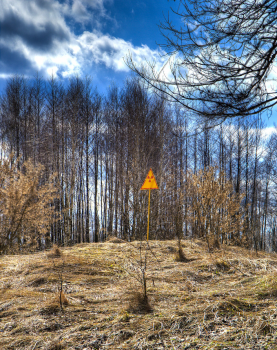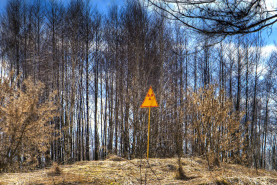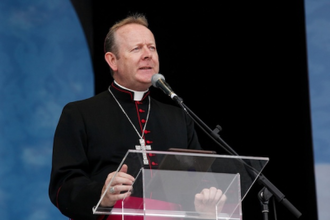Remembering the Chernobyl Disaster

Red Forest Hill by Timm Suess - radioactive forest, Wiki Image
On Sunday, 26 April, the world will mark International Chernobyl Disaster Remembrance Day. In the early hours of April 26,1986, an explosion occurred in reactor No. 4 after a safety test, at the Chernobyl Nuclear Power Plant in Ukraine, blowing off the top and spewing huge amounts of radioactive material into the sky. This is the world's worst nuclear accident. The explosion "spread a radioactive cloud over large parts of the Soviet Union, now the territories of Belarus, Ukraine and the Russian Federation. Nearly 8.4 million people in the three countries were exposed to the radiation" (UN).
Recently, on April 4, 2020 a fire started in a forest in the western part of the Plant's zone of alienation/exclusion zone in northern Ukraine. For 10 days more than 400 firefighters struggled to extinguish the fires, while helicopters and planes doused water from above. According to reports, one part of the fire reached Pripyat, a "ghost town located 2 km (1.24 miles) from the defunct No 4 nuclear reactor" ( www.insider.com ) and the Pidlisny radioactive waste disposal site. By 14 April reports were that while there were still some smouldering parts of the forest floor, there was no open fire left. Rain also helped to extinguish the fires which had sparked radiation fears.
The exclusion zone comprises "30-kilometre circle of land, formerly home to 200,000 people, surrounding the reactor town of Pripyat...Radiation levels around the plant remain so high that authorities do not expect the area to be inhabitable for between 180 and 320 years"( www.theglobeandmail.com ).
The European Parliament Think Tank report in 2016 states, inter alia: "The Chernobyl fallout had a major impact on both agricultural and natural ecosystems in Belarus, Russia and Ukraine, as well as in many other European countries. Radionuclides were taken up by plants and later by animals. In some areas, they were subsequently found in milk, meat, forest food products, freshwater fish and wood. Environmental impacts vary according to location and ecosystem. Forests and fresh water bodies have been among the most affected ecosystems."
It should be noted that it was only in July 2019 that the New Safe Confinement or New Shelter was completed. This is a structure built to confine the remains of the number 4 reactor unit at Chernobyl Nuclear Power Plant. It is "designed to prevent the release of radioactive contaminants, protect the reactor from external influence, facilitate the disassembly and decommissioning of the reactor, and prevent water intrusion." This mega project cost approx US$2.3 billion, provided by "over 45 donor nations...The scope of the project in terms of international cooperation is one of the largest ever seen in the field of nuclear safety." (UN).
Social scientist and energy policy expert, Benjamin K Sovacool, has reported that worldwide there have been 99 accidents at nuclear power plants from 1952 to 2009. Research shows that many of the major nuclear accidents, including that at Chernobyl, have been directly attributable to operator or human error.
Although the UN estimates that only 50 deaths can be directly attributed to the disaster at Chernobyl in 1986, "a study published in 2005 by the World Health Organisation estimates that there may eventually be up to 4,000 additional cancer deaths related to the accident among those exposed to significant radiation levels. Radioactive fallout from the accident was concentrated in areas of Belarus, Ukraine and Russia. Other studies have estimated as many as over a million eventual cancer deaths from Chernobyl" . Many have suffered from birth defects as a result of the radiation.
Much has been written about the social, economic, and environmental costs of this disaster. And while some worry about terrorists attacking nuclear plants, we must not forget that, in fact, "Nuclear reactors become preferred targets during military conflict and, over the past three decades, have been repeatedly attacked during military air strikes, occupations, invasions and campaigns" (See Sovacool's 2011 book: Contesting the Future of Nuclear Power: A Critical Global Assessment of Atomic Energy).
Brian Michael Jenkins warn that "Nuclear weapons materials on the black market are a global concern." We must also be concerned about the number and sophistication of cyber attacks that are on the rise. Hackers have demonstrated that they can hack into the computers of a nuclear plant operator. And legal experts have stated that it was an illegal act to use Stuxnet, a computer worm, to switch off safety devices in a country's nuclear facilities, causing centrifuges to spin out of control. God save humankind from ourselves!
Leela Ramdeen is Chair of the Catholic Commission for Social Justice in the Archdiocese of Port of Spain, Trinidad & Tobago, (CCSJ) and Director of CREDI
Website: http://rcsocialjusticett.org
Facebook: www.facebook.com/ccsjtt
Instagram: ammrcatholictt
Twitter: @ammrcatholictt1


















